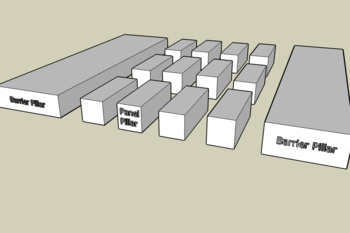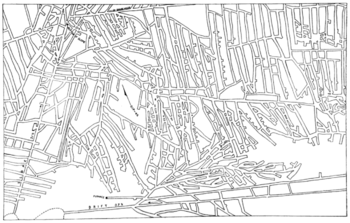Room and pillar mining
Room and pillar (variant of breast stoping), is a mining system in which the mined material is extracted across a horizontal plane, creating horizontal arrays of rooms and pillars. To do this, "rooms" of ore are dug out while "pillars" of untouched material are left to support the roof overburden. Calculating the size, shape, and position of pillars is a complicated procedure, and is an area of active research.[1] The technique is usually used for relatively flat-lying deposits, such as those that follow a particular stratum. Room and pillar mining can be advantageous because it reduces the risk of surface subsidence compared to other underground mining techniques.[2] It is also advantageous because it can be mechanized, and is relatively simple. However, because significant portions of ore may have to be left behind, recovery and profits can be low.[1] Room and pillar mining was one of the earliest methods used,[3] although with significantly more man-power.
The room and pillar system is used in mining coal, gypsum,[4] iron,[5] and uranium[6] ores, particularly when found as manto or blanket deposits, stone and aggregates, talc, soda ash and potash.[7] It has been used worldwide from the Czech Republic[2] to China[8] to the US.[4]
Process
Stage 1—exploration and development
Planning for the development of room and pillar mines operates in much the same way as other mining methods,[9] and begins with establishing ownership of the mine. Following this, the geology of the mine must be analysed, as this will determine factors like the lifespan of the mine, the production requirements, and the cost to develop and maintain.[9]
Next, mine layout should be determined, as factors like ventilation, electrical power, and haulage of the ore must be considered[4][9] in cost analysis. Due to the non-homogeneous nature of mineral deposits typically mined by room and pillar, mine layout must be mapped very carefully.[9] It is desirable to keep the size and shape of rooms and pillars consistent, but some mines strayed from this formula due to lack of planning and deposit characteristics.[4] Mine layout includes the size of rooms and pillars in the mines, but also includes factors like the number and type of entries, roof height, ventilation, and cut sequence.[9]
Mine layout

Room and pillar mines are developed on a grid basis except where geological features such as faults require the regular pattern to be modified. The size of the pillars is determined by calculation. The load-bearing capacity of the material above and below the material being mined and the capacity of the mined material will determine the pillar size.[9]
Random mine layout makes ventilation planning difficult, and if the pillars are too small, there is the risk of pillar failure. In coal mines, pillar failures are known as squeezes because the roof squeezes down, crushing the pillars. Once one pillar fails, the weight on the adjacent pillars increases, and the result is a chain reaction of pillar failures. Once started, such chain reactions can be extremely difficult to stop, even if they spread slowly.[10] To prevent this from happening, the mine is divided up into areas or panels.[9] Pillars known as barrier pillars separate the panels. The barrier pillars are significantly larger than the "panel" pillars and are sized to allow them to support a significant part of the panel and prevent progressive collapse of the mine in the event of failure of the panel pillars.[9]
Stage 2—mining
Traditionally, the act of mining consists of three steps. First, the deposit is "undercut", where a slot is cut as deep as possible along the bottom of a section of ore. This undercut allows for a manageable pile of rock in later stages. The second step was the drilling and blasting of the section. This creates a pile of ore that is loaded and hauled out of the mine—the final step of the mining process.[9] More modern room and pillar mines use a more "continuous" method, that uses machinery to simultaneously grind off rock and move it to the surface.[11]
Other processes, such as backfill, where discarded tailings are unloaded into mined-out areas,[8] can be used, but are not required. Retreat mining (below) is an example of a process like this.
Retreat mining
Retreat mining is often the final stage of room and pillar mining. Once a deposit has been exhausted using this method, the pillars that were left behind initially are removed, or "pulled", retreating back towards the mine's entrance. After the pillars are removed, the roof (or back) is allowed to collapse behind the mining area. Pillar removal must occur in a very precise order to reduce the risks to workers, owing to the high stresses placed on the remaining pillars by the abutment stresses of the caving ground.
Retreat mining is a particularly dangerous form of mining. According to the Mine Safety and Health Administration (MSHA), pillar recovery mining has been historically responsible for 25% of American coal mining deaths caused by failures of the roof or walls, even though it represents only 10% of the coal mining industry.[12] Retreat mining cannot be used in areas where subsidence is not acceptable, reducing profitability.[12]
Sometimes retreat mining is not used and the underground space is repurposed as climate controlled storage or office space instead.[13][14]
Stage 3—maintenance and remediation
Many room and pillar mines have been abandoned for as long as 100 years.[5] This drastically increases the risk of subsidence unless properly maintained,[5] however, maintenance does not often occur.[6]
Mention of "environmental stewardship" is often mentioned by mining companies, but no examples of how this is being done can be found.[9]
History

Room and pillar mining is one of the oldest mining methods. Early room and pillar mines were developed more or less at random, with pillar sizes determined empirically and headings driven in whichever direction was convenient.[15]
Room and pillar mining was in use throughout Europe as early as the 13th century,[16] and the United States since the late 18th century. It is still in use throughout the US,[11] but has slowed or stopped entirely in parts of Europe.[16]
Coal mining in the United States has nearly always operated with a room and pillar layout, although originally operated with significantly more man-power.[9]
Room and pillar mining of gypsum was used in Iowa beginning in 1892, and was phased out of use in 1927 due to low recovery and development of technologies that made surface mining more practical, safe, and cost effective.[4]
Modern use
Modern room and pillar mines can be few and far between. This is due to many factors, including the dangers to miners associated with subsidence, increasing use of other methods with more mechanization, and the decreasing cost of surface mining.
Advantages
Room and pillar mining is not particularly dependent on the depth of the deposit. At particularly deep depths, room and pillar mining can be more cost effective compared to strip mining due to the fact that significantly less overburden needs to be removed.[8] This means that today, room and pillar mining is mostly used for high grade, but small, deep deposits.
Disadvantages
Due to a recovery rate as low as 40% in some cases,[4] room and pillar mining cannot compete in terms of profitability with many modern, more mechanized types of mining such as longwall or surface mining.
Abandoned mines have a tendency to collapse. In remote areas, collapses can be dangerous to wildlife,[17] but subsidence of abandoned mines can be hazardous to infrastructure above and nearby.[5][16]
References
Note
- Kim, Jong-Gwan; Ali, Mahrous A. M.; Yang, Hyung-Sik (2018-10-27). "Robust Design of Pillar Arrangement for Safe Room-and-Pillar Mining Method". Geotechnical and Geological Engineering. 37 (3): 1931–1942. doi:10.1007/s10706-018-0734-1. ISSN 1573-1529.
- Hudeček, V.; Šancer, J.; Zubíček, V.; Golasowski, J. (January 2017). "Experience in the Adoption of Room & Pillar Mining Method in the Company OKD, a.s., Czech Republic". Journal of Mining Science. 53 (1): 99–108. doi:10.1134/s1062739117011908. hdl:10084/124488. ISSN 1062-7391.
- Croyle, Floyd D.; Kohler, Jeffrey L.; Bise, Christopher J. (November 1987). "Maximum Demand and Demand Factors in Underground Coal Mining". IEEE Transactions on Industry Applications. IA-23 (6): 1105–1111. doi:10.1109/tia.1987.4505039. ISSN 0093-9994.
- Marshall, Lawrence G. (1959). Mining methods and costs, Iowa Gypsum deposits. Bureau of Mines. OCLC 680481821.
- Grgic, Dragan; Homand, Francoise; Hoxha, Dashnor (October 2003). "A short- and long-term rheological model to understand the collapses of iron mines in Lorraine, France". Computers and Geotechnics. 30 (7): 557–570. doi:10.1016/S0266-352X(03)00074-0.
- Paul, Michael, et al. "Mine flooding and water management at underground uranium mines two decades after decommissioning." Proc. IMWA Conference. 2013.
- Hamrin, Hans (1986). Guide to underground mining methods and applications. Stockholm, Sweden: Atlas Copco.
- Zhou, Nan; Li, Meng; Zhang, Jixiong; Gao, Rui (2016-11-29). "Roadway backfill method to prevent geohazards induced by room and pillar mining: a case study in Changxing coal mine, China". Natural Hazards and Earth System Sciences. 16 (12): 2473–2484. doi:10.5194/nhess-16-2473-2016. ISSN 1684-9981.
- Bise, Christopher J. Modern American coal mining : methods and applications. ISBN 9780873353953. OCLC 900441678.
- S. O. Andros, Coal Mining in Illinois, Illinois Coal Mining Investigations, Bulletin 13, Vol II, No 1, University of Illinois, September 1915.
- Sunrise Coal LLC. "Room and Pillar Mining: Modern Coal Mining at Its Best". Sunrise Coal.
- Singh, Rajendra; Mandal, P.K.; Singh, A.K.; Kumar, Rakesh; Sinha, Amalendu (May 2011). "Coal pillar extraction at deep cover: With special reference to Indian coalfields". International Journal of Coal Geology. 86 (2–3): 276–288. doi:10.1016/j.coal.2011.03.003. ISSN 0166-5162.
- "Springfield Underground". Retrieved 23 May 2019.
- "Louisville Underground". Retrieved 23 May 2019.
- C. M. Young, Percentage of Extraction on of Bituminous Coal with Special Reference to Illinois Conditions, Engineering Experiment Station Bulletin No. 100, University of Illinois, page 130.
- "Subsidence due to abandoned mining in the South Wales coalfield, UK: causes, mechanisms, and environmental risk assessment". International Journal of Rock Mechanics and Mining Sciences & Geomechanics Abstracts. 29 (3): A202. May 1992. doi:10.1016/0148-9062(92)94157-m. ISSN 0148-9062.
- Sun, He; Zhang, Qin; Zhao, Chaoying; Yang, Chengsheng; Sun, Qifa; Chen, Weiran (2017). "Monitoring land subsidence in the southern part of the lower Liaohe plain, China with a multi-track PS-InSAR technique". Remote Sensing of Environment. 188: 73–84. doi:10.1016/j.rse.2016.10.037. ISSN 0034-4257.